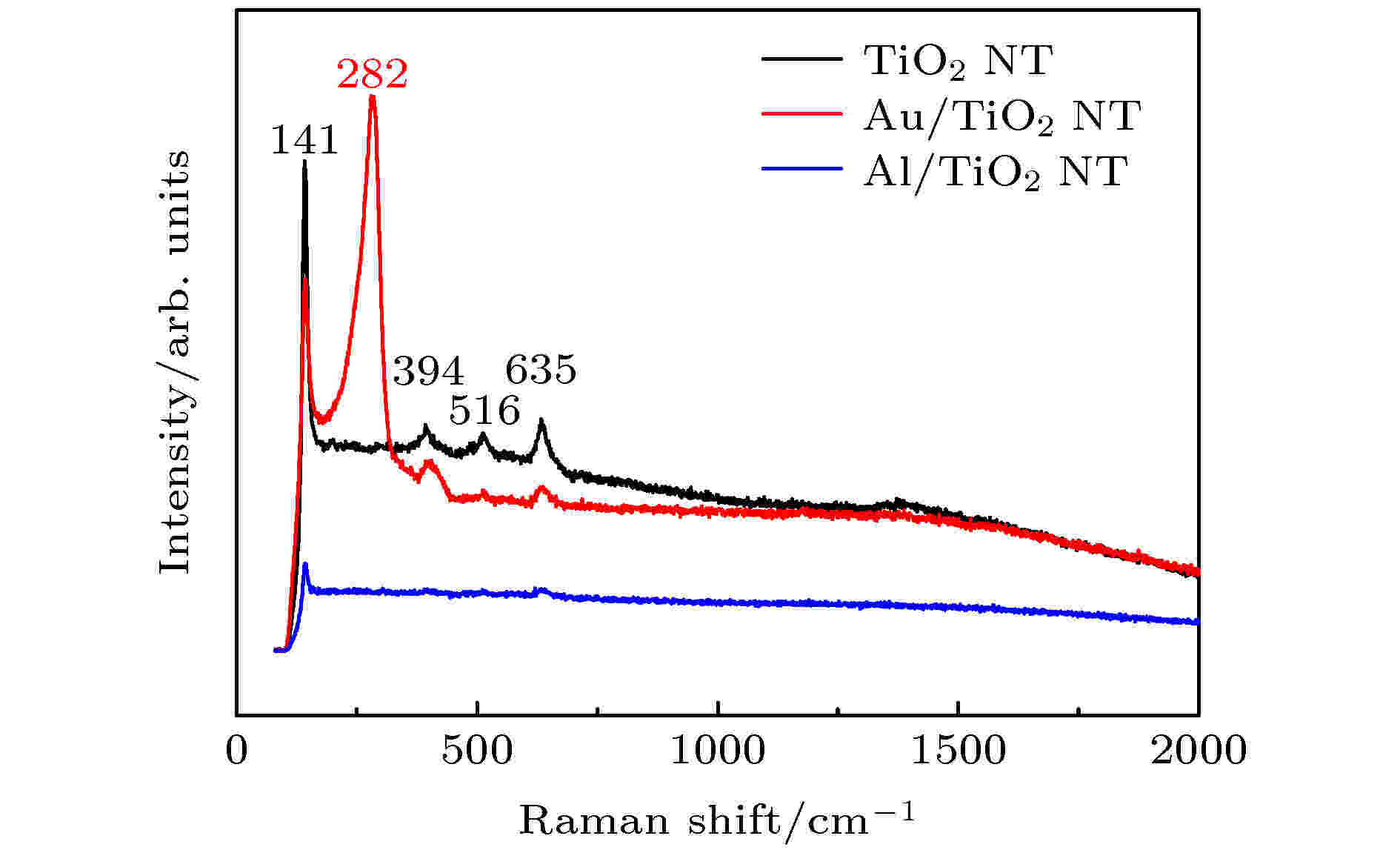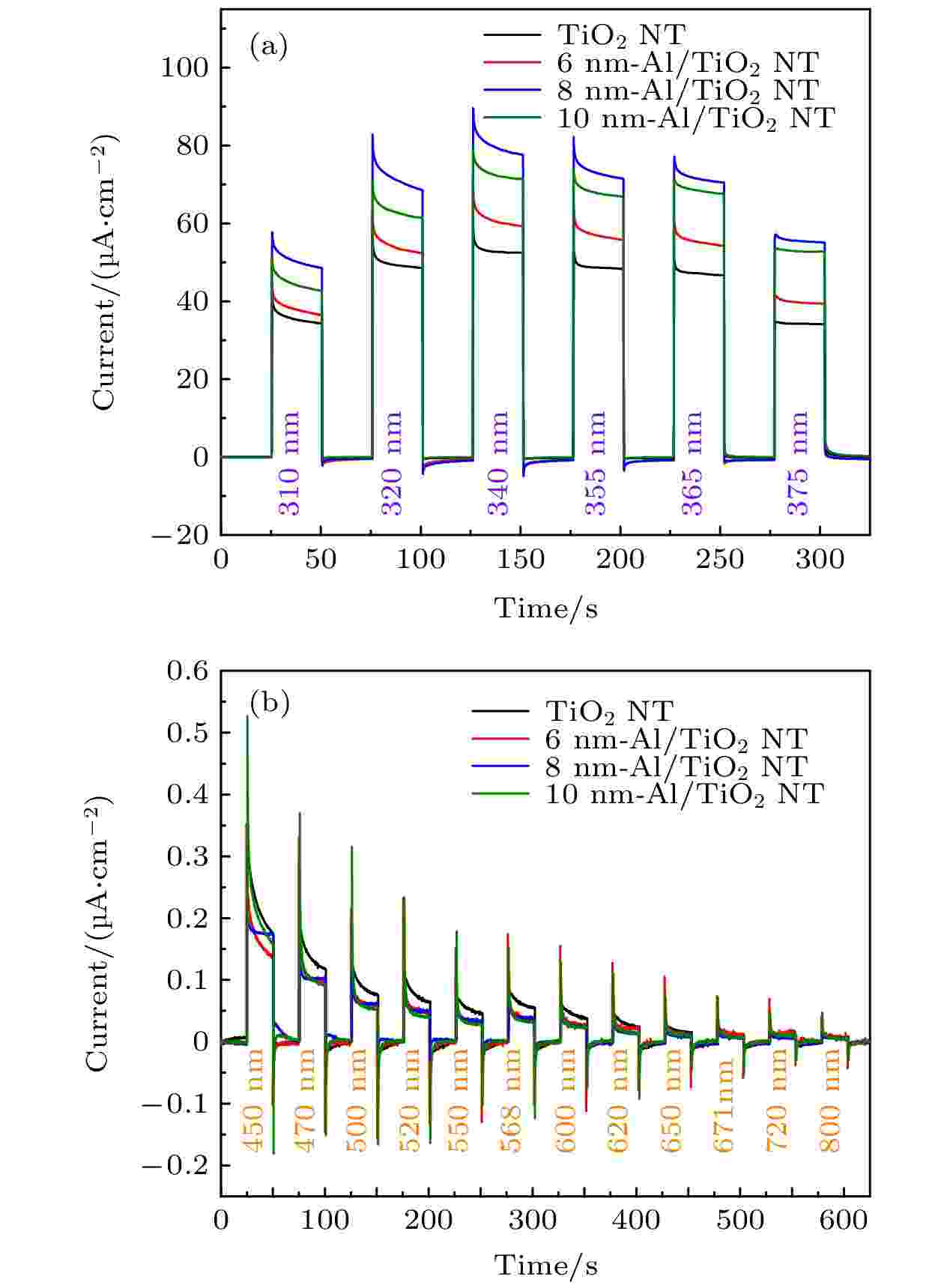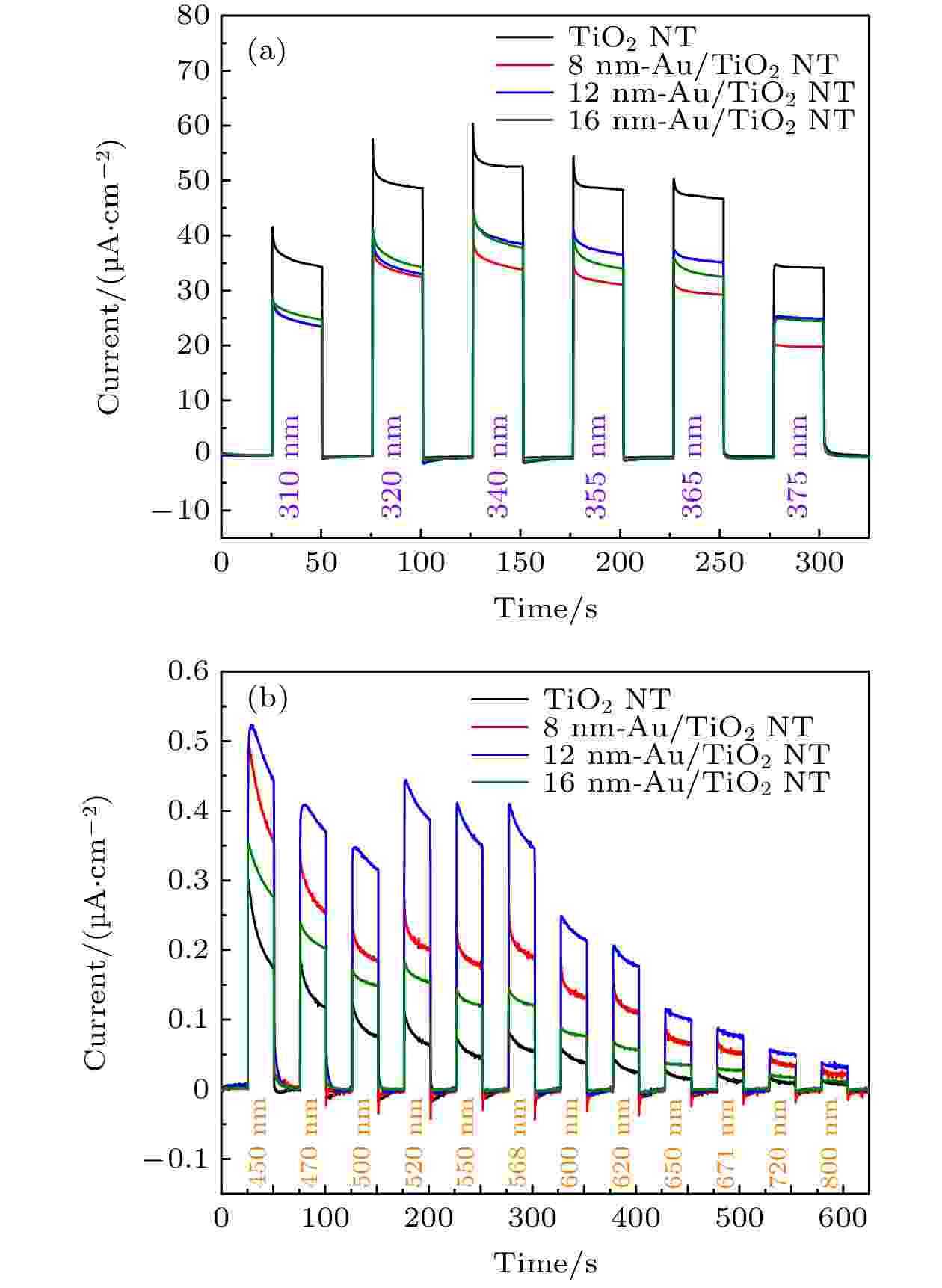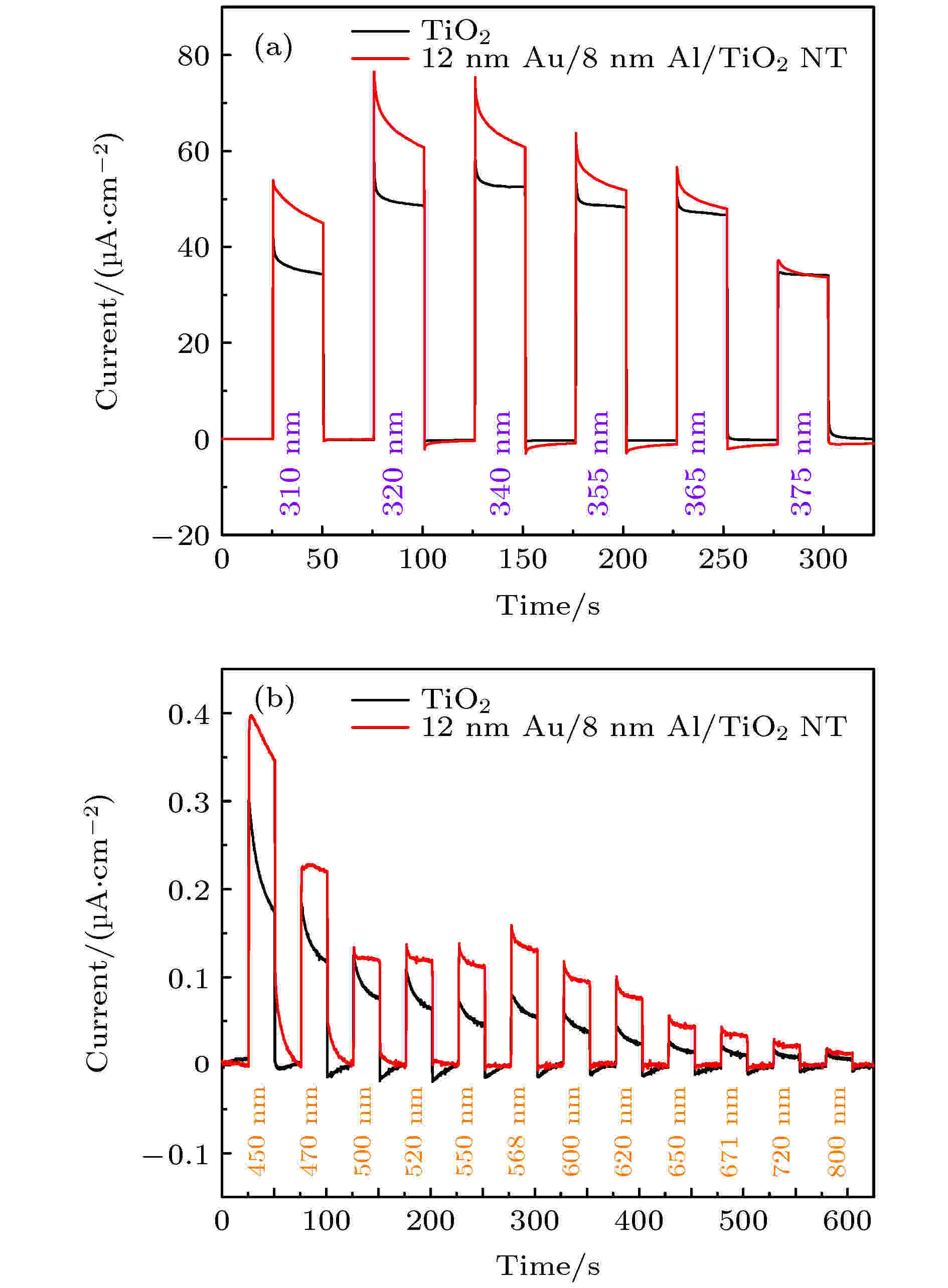全文HTML
--> --> -->除了改变TiO2的结构以外, 还可以利用金属纳米颗粒的表面等离激元效应拓展TiO2的光吸收范围, 从而提高其光催化效率. Zhang课题组[19]利用光还原方法将Au纳米颗粒与TiO2纳米管复合, 发现复合结构在可见光作用下光水分解性能极大增强. 众所周知, 贵金属(例如金、银以及铂等)纳米颗粒的吸收波长在可见光范围, 因此它们可以促进宽带隙的半导体材料吸收可见光. 然而, 在紫外光照射下, 这类纳米颗粒无法增强TiO2薄膜的光吸收性能. 虽然在金属-TiO2界面处的肖特基势垒能够促使TiO2薄膜中的电子转移到金属中, 从而降低其电子-空穴的复合, 但是大量的金属颗粒存在于TiO2表面, 其遮光效应也有可能导致TiO2薄膜对紫外光吸收能力的降低[20]. 与贵金属颗粒在可见光作用下产生表面等离激元共振效应相比, Al纳米颗粒的局域表面等离激元共振频率可以从紫外光区调节到可见光区域, 只要合理控制Al纳米颗粒的结构、尺寸和周期性等结构参数[21]. 这一特点有效地解决了贵金属纳米颗粒只能在可见光区增强光吸收能力的限制.
本文采用电子束蒸发和原子层沉积相结合的方法制备了Au/Al双金属纳米颗粒负载TiO2纳米管的复合结构, 并对其光电流性能进行了研究. 利用双金属Au和Al纳米颗粒的表面等离激元共振频率互补的特点, 不仅有效地增强和拓宽了TiO2纳米管的光吸收, 而且实现了从紫外到可见光范围内的光电流增强.
2.1.实验材料准备
金颗粒(99.99%)、铝颗粒(99.99%)和钛靶(99.99%)均为科特·莱思科公司生产; 阳极氧化铝模板(Al2O3)为深圳拓扑精膜科技有限公司生产; 四氯化钛(TiCl4)为麦克林(Macklin)试剂公司生产; 盐酸(HCl)、硫酸钠(Na2SO4)和无水乙醇(CH3CH2OH)购自于国药集团化学试剂有限公司. 所有试剂均为分析纯, 没有做进一步的提纯和处理.2
2.2.样品制备
以大面积有序的氧化铝纳米管为模板, 采用原子层沉积(ALD)技术制备TiO2纳米管的有序阵列. 具体制备方法如下: 固定AAO模板, 并放入ALD反应腔室中. 使用四氯化钛(TiCl4)作为反应的钛源, 高纯水(H2O)作为氧源, 沉积一定循环数, 获得不同厚度的TiO2纳米管阵列.Al和Au纳米颗粒采用电子束热蒸发技术制备. 将制备好的TiO2纳米管置于镀膜仪蒸发源的正上方, 以便金属材料可以垂直沉积在纳米管中. 镀膜仪的真空值设置为5×10–4 Pa, 金属材料的蒸镀速率均为0.1 ?/s, 通过控制沉积时间达到控制沉积厚度的目的. 本实验中, 沉积厚度约为3—18 nm. 最后将制备好的样品在氩气氛围中400 ℃退火2 h. 本文采用双通的AAO模板, 所制备的TiO2纳米管也具有双通结构的特点, 孔径尺寸约为300 nm.
2
2.3.样品形貌、结构、成分、吸收光谱表征
通过X射线光电子能谱(X-ray photoelectron spectroscopy, XPS, PHI5000 VersaProbe)表征材料表面元素及其化学状态; 通过拉曼光谱(Raman spectroscopy, Jobin Yvon HR800)区分材料中分子的不同晶态, 其具有定性和定量功能, 测试条件为785 nm 10%强度激光, 曝光时间为10 s. 通过紫外-可见-近红外光谱仪(ANDO AQ-6315 A)表征样品的吸收光谱, 该光谱仪工作范围为紫外350 nm到近红外1750 nm.2
2.4.电化学测量
样品的电化学性能表征是在室温下利用电化学工作站(CHI660 E, 上海辰华仪器有限公司), 采用三电极测试系统进行测试. 三电极系统包括工作电极(样品电极)、对电极(Pt电极)和参比电极(Ag/AgCl电极). 在0.1 mol/L Na2SO4电解液中测试了样品在不同波长入射光照射下的光电流-时间曲线(i-t曲线). 研究在偏置电压一定时, 样品的光电流密度随时间和入射波长的变化. 图 1 纯TiO2纳米管(NT)和负载了Au或Al纳米颗粒的TiO2纳米管(NT)复合结构的XPS图谱 (a) Ti 2p; (b) Au 4f; (c) Al 2p
图 1 纯TiO2纳米管(NT)和负载了Au或Al纳米颗粒的TiO2纳米管(NT)复合结构的XPS图谱 (a) Ti 2p; (b) Au 4f; (c) Al 2pFigure1. XPS spectra of pure TiO2 nanotubes (NT), Au/TiO2 and Al/TiO2 nanotubes: (a) Ti 2p; (b) Au 4f; (c) Al 2p.
图1(b)为Au的4f峰, 分别在83.3和86.9 eV处, 对应于Au的4f7/2和4f5/2轨道电子. 相比于Au单质的4f峰, 复合结构中Au的4f峰显现出一定的负偏移特性. 图1(c)为Al/TiO2的XPS曲线(黑色), 可以看到在72.7 eV处存在1个明显的峰. 通过比对发现这峰对应于化合物氧化铝(Al2O3)中的Al3+ 2p峰, 这是由于Al单质的氧化使得在其纳米颗粒表面形成了Al2O3, 因此会观察到Al3+峰. 为了更清楚地理解负载了Al纳米颗粒的复合结构的成分, 利用XPS peak软件对黑色曲线进行了分峰处理, 分别得到了绿色和蓝色两条曲线.
如图1(c)蓝色曲线所示, 在71.6 eV处发现了金属Al中的Al0 2p峰. 通过比较, 可以看到化合物Al2O3产生的峰比单质Al强, 这是因为XPS的扫描深度约几纳米, 所以Al 2p峰中Al3+的信号强度大于Al0. 为了进一步验证图1(c)曲线给出的结果, 将绿色和蓝色曲线进行了拟合, 得到了与实验测量得到的黑色曲线符合得非常好的红色曲线. 此外, 在Al/TiO2样品中也观察到Al的XPS峰也表现出负偏移特性.
复合结构中Au 4f峰和Al 2p峰表现出的负偏移与Ti 2p峰的正偏移是相对应的. 根据Arrii等[23]的研究, 金属纳米颗粒的量子尺寸效应和金属与半导体材料功函数的差值导致了Au 4f 和Al 2p结合能向低结合能方向移动. 首先, 由于金属颗粒尺寸小, 表面原子数在总原子数中占据了较大的比例, 那么表面原子能级的移动会对整个颗粒产生较大的影响, 从而引起金属中相应的电子轨道能级向低结合能方向移动. 此外, 两种材料功函数的不同导致电子从功函数小的半导体流向功函数大的金属, 使金属表现出俘获电子的特性.
对纯TiO2纳米管, 以及Au/TiO2和Al/TiO2复合纳米管结构的拉曼光谱进行了表征(图2). 从图2可以看出, 当使用波长785 nm激光激发时, 141 (Eg), 394 (B1g), 516 (A1g), 635 (Eg) cm–1位置处分别出现4个拉曼峰, 这4个峰对应于锐钛矿结构的TiO2的特征峰[24]. 复合纳米管拉曼信号的减弱表明结构内缺陷增加[25]. 但缺陷的存在对于俘获光电子和抑制电荷复合是有利的. 此外, 复合结构中的金属纳米颗粒可起到电子陷阱的作用, 这将有利于光电子的转移, 进一步降低载流子的复合[26].
 图 2 纯TiO2纳米管(黑线)、负载Au纳米颗粒(红线)和负载Al纳米颗粒(蓝线)的TiO2纳米管的拉曼光谱
图 2 纯TiO2纳米管(黑线)、负载Au纳米颗粒(红线)和负载Al纳米颗粒(蓝线)的TiO2纳米管的拉曼光谱Figure2. Raman spectra of pure TiO2 nanotubes (black line), Au/TiO2 (red line) and Al/TiO2 (blue line).
为了探究负载金属纳米颗粒对TiO2纳米管光电性能的影响, 在保证各入射波长的功率相同的情况下, 分别测试了纯TiO2纳米管和分别负载不同数量和尺寸的Al纳米颗粒的TiO2纳米管在紫外和可见光照射下的光电流(如图3所示). 其中, 图3(a)给出了在310—375 nm紫外光的照射下, 各样品的光电流曲线. 可以看到, 负载Al颗粒后的TiO2纳米管光电流均有不同程度的增强, 最大增强幅度达到了50%, 并且Al纳米颗粒的负载量最优值为沉积了8 nm厚度的Al薄膜, 然后退火所形成的Al纳米颗粒负载的TiO2复合纳米管结构. 图3(b)给出了样品在可见光照射下(450—800 nm)的光电流曲线. 图中曲线显示出TiO2纳米管在可见区域有较微弱的光响应, 这主要是由于TiO2纳米管在生长过程中存在缺陷和表面态, 从而引起了可见光吸收. 由于Al纳米颗粒的等离激元共振位置处于紫外区域, 所以在紫外光作用下, 复合结构的光电流有所增加. 然而, 在可见光作用下, Al颗粒的存在反而会影响TiO2纳米管对光的吸收, 因此Al/TiO2复合结构的光电流有所下降.
 图 3 纯TiO2纳米管和Al-TiO2复合纳米管的电流-时间曲线 (a)入射光为紫外区域310—375 nm; (b)入射光为可见区域450—800 nm
图 3 纯TiO2纳米管和Al-TiO2复合纳米管的电流-时间曲线 (a)入射光为紫外区域310—375 nm; (b)入射光为可见区域450—800 nmFigure3. Photocurrent of pure TiO2 nanotubes and Al/TiO2 composite nanotubes: (a) The incident light is 310–375 nm in ultraviolet (UV) region; (b) the incident light is 450–800 nm in visible region.
图4(a)是在紫外光照射下纯TiO2纳米管和Au/TiO2复合纳米管的光电流曲线. 可以看出, Au/TiO2复合纳米管的光电流相较于TiO2纳米管有不同程度的降低, 这是由于金纳米颗粒的存在影响了TiO2对紫外光的吸收. 在样品制备过程中, 金纳米颗粒是通过对金薄膜退火获得的, 因此颗粒尺寸分布不均匀, 在563 nm附近表现出宽带吸收特性. Au/TiO2纳米管在450—800 nm区域的光电流均有一定程度的增加, 最大增幅出现在568 nm处, 其光电流增大了约400%. 由此可以得出结论: Al纳米颗粒的存在增强了TiO2纳米管紫外光区域光电流, 但同时抑制了可见光区域光电流, Au纳米颗粒的存在能够增强TiO2纳米管在可见光区域的光电流, 但会抑制其在紫外光区域光电流. 由此, 我们想到在TiO2纳米管中同时沉积12 nm厚度的Au薄膜及8 nm厚的Al薄膜, 退火后得到双金属纳米颗粒负载的Au/Al/TiO2复合结构.
 图 4 纯TiO2纳米管和负载不同量Au纳米颗粒TiO2纳米管的电流-时间曲线 (a)入射光为紫外区域310—375 nm; (b)入射光为可见区域450—800 nm
图 4 纯TiO2纳米管和负载不同量Au纳米颗粒TiO2纳米管的电流-时间曲线 (a)入射光为紫外区域310—375 nm; (b)入射光为可见区域450—800 nmFigure4. Photocurrent of pure TiO2 nanotubes and Au/TiO2 composite nanotubes: (a) The incident light is 310–375 nm in UV region; (b) the incident light is 450–800 nm in visible region.
在对其可见光区和紫外光区的光电流进行了测量(如图5所示)后发现, 同时负载了Au和Al双金属纳米颗粒后, 利用它们等离激元共振位置的互补的特点, 使得复合纳米管在整个紫外-可见光区域的光电流都得到明显的增强.
 图 5 纯TiO2纳米管和同时负载Au和Al纳米颗粒TiO2纳米管的i-t曲线 (a)入射光为紫外区域310—375 nm; (b)入射光为可见区域450—800 nm
图 5 纯TiO2纳米管和同时负载Au和Al纳米颗粒TiO2纳米管的i-t曲线 (a)入射光为紫外区域310—375 nm; (b)入射光为可见区域450—800 nmFigure5. Photocurrent of pure TiO2 nanotubes and Au/Al/ TiO2 composite nanotubes: (a) The incident light is 310– 375 nm in UV region; (b) the incident light is 450–800 nm in visible region.
